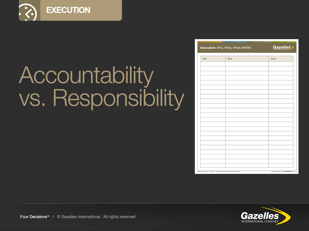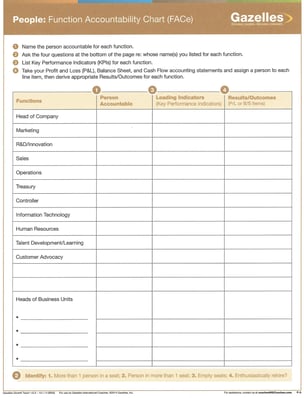 This week in a weekly meeting with one of my customers the team discussed how they’d failed to follow through on a specific assignment they’d discussed for a father’s day promotion. It started as a brainstorming session and wrapped up with an idea to promote a specific product. Everyone agreed that it was a great idea, yet no one took responsibility to implement it and take initiative. (For more on this subject check out The Leadership Difference - Responsibility and Accountability.)
This week in a weekly meeting with one of my customers the team discussed how they’d failed to follow through on a specific assignment they’d discussed for a father’s day promotion. It started as a brainstorming session and wrapped up with an idea to promote a specific product. Everyone agreed that it was a great idea, yet no one took responsibility to implement it and take initiative. (For more on this subject check out The Leadership Difference - Responsibility and Accountability.)
Eventually things got sorted out and several people stepped up and took the initiative, however the delay in getting someone to take charge probably cost them a day if not more in sales. What I loved about the meeting is the ownership several leadership members took to be accountable and accept responsibility for this and to take steps in the future to prevent this from ever occurring again.
How do you prevent this? We’ve discussed our Gazelles tool in Raising the Bar on Accountability to help track and keep your time responsible for the tasks and projects in your organization. Several of my customers use software such as Asana for this. The key here is to have something as a place holder to keep everyone accountable. However this doesn’t prevent situations like this occurring. If you’re having a meeting, have an agenda, and make sure you conclude your meeting with the accountability tool. This may require you to have one person in charge of the meeting, setting the agenda and taking responsibility for assigning responsibility.
Strategic Discipline’s meeting rhythms automatically include these steps since each meeting, with the exception of the daily huddle, has a segment designated for reviewing accountabilities. When customers conduct meetings outside these structured rhythms it can be easy to forget to assign someone to lead the meeting, and always have an agenda with a wrap that ties up any loose ends.
Finishing a meeting without anyone taking accountability to complete the required action steps is one thing. What happens when the key roles in your company fail to have accountability?
In Rockefeller Habits 4 Decisions Tools - People we discussed our  Gazelles Function Accountability Chart (FACe) tool. The role of this tool is to determine the right seats in your organization, who sits in them, and what the key leading and lagging indicators are their responsibility.
Gazelles Function Accountability Chart (FACe) tool. The role of this tool is to determine the right seats in your organization, who sits in them, and what the key leading and lagging indicators are their responsibility.
When conducting this exercise in a public or private workshop it becomes quickly clear that most companies have not only defined their key seats, they’ve not defined who is responsible for the roles. Often times we discover seats where the specific role has several people responsible, or no one responsible. This is at the leadership level! Imagine what it’s like for staff or reporting positions?
This comes back to Jim Collins corollary from Good to Great, “First Who Then What!” Jim Collins’ asks 3 very important questions once you have answered the question “do we have the right people on the bus?”
These questions are:
- Do we have the right seats (roles defined in the company)?
- Are the right people in those seats (Do they possess the proper skills, talent and abilities necessary to succeed)?
- Are the right people in the right seats doing the right things? (Are they focused on the most important priorities each quarter, month, week and day?).
Think of your organization – the roles you have defined today – and the people in those roles. Do you currently have a written (documented) organizational chart with each position (role) title and the name of the person occupying that role? Is it current within the past 90 days?
If not, don’t worry, most growth organizations don’t; BUT, you should strive to have one that is current each quarter so everyone is clear on who does what.
Assuming you have an organizational chart – even if only in your mind. Here are the 3 vitally practical questions you need to ask to ensure you have a clear, accountable organization:
- Do we have any seats (roles) that have 2 or more people occupying them?
- Do we have any team members (leaders) that are occupying too many seats (to be effective)?
- Are there seats (roles) we have empty (no one accountable for them) or have roles we have not defined that we desperately need to succeed?
Download the PACe tool and complete this chart filling first the names that fit into each key role in your organization. Don’t concern yourself with the titles provided here, create your own to fit the specific roles in your organization. The titles are simply a starting point.
Once you’ve completed filling in your names ask the three questions above. What are your answers?
Chances are you have a number of seats where more than one person fills the role. More than likely, especially if you’re a smaller organization you have a name in too many seats. It’s probable this is a major bottle neck. It’s often not the issue that the person isn’t capable, he/she is simply being asked to do too much. Finally do you have seats where no one is, where there should be someone? Many times the seat unoccupied is Customer Advocacy. Do you ever wonder why you have customer issues? It’s because no one is truly listening to your customers and taking up their cause to improve execution and customer service issues.
This is frequently one of the most important exercises we do. A company I started working with in June quickly discovered that no one was truly accountable at the top of the organization. Two brothers were essentially the CEO/President with both too busy serving as sales people to bring in much needed revenue. It’s no wonder they never made much profit. No one was minding the store and keeping track of any of the essential metrics to track expenses, profit margin, or operational errors.
Putting one person in charge made an immediate and significant change to their business.
Just remember, when everyone is accountable, then no one is. When you have more than one person in a key seat you have confusion, often chaos and clear lack of accountability.
One of my customers demonstrated this week in their monthly meeting how to present the company’s strategy consistently with great emphasis on getting engagement from his leadership team. That’s our next blog.






.jpeg?width=150&height=135&name=Hand%20with%20marker%20writing%20the%20question%20Whats%20Next_%20(1).jpeg)

